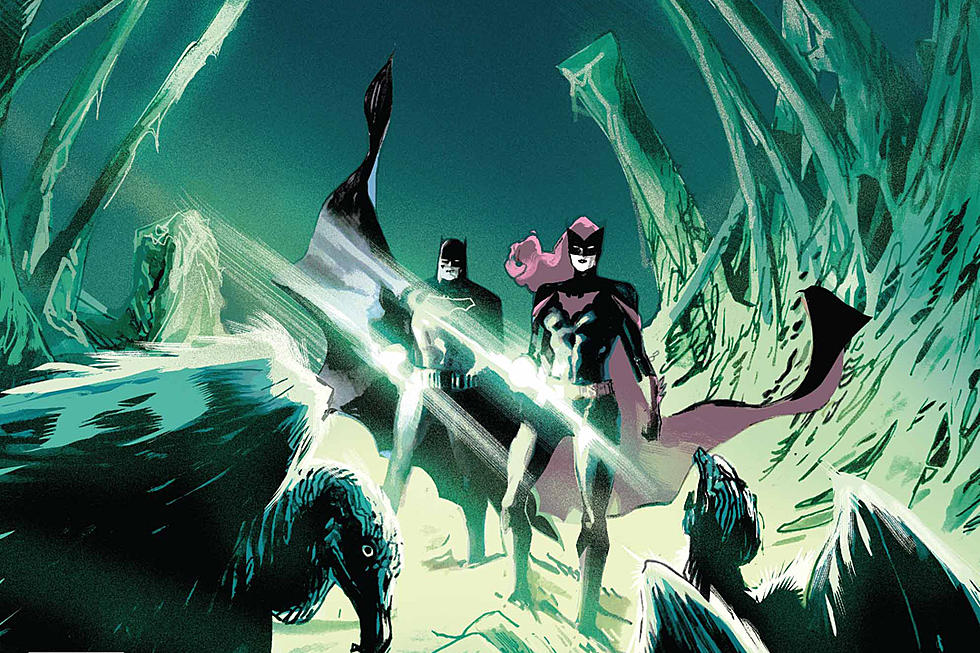![Beastly Romance from Marguerite Bennett and Trungles in ‘Beauties’ [Review]](http://townsquare.media/site/622/files/2015/12/beauties_cover.png?w=980&q=75)
Beastly Romance from Marguerite Bennett and Trungles in ‘Beauties’ [Review]
Beauties is a one-shot, available now from Rosy Press, written by Marguerite Bennett, with art by Trungles and letters by Rachel Deering. As you can probably tell from the cover, it’s a variation on the “Beauty and the Beast” story, but it’s a variation unlike any we’ve seen before.
Beauties is unapologetically a fantasy romance. In fact, it’s more than that; it’s a fairy tale. It even begins with “Once upon a time.” Bennett takes the “Beauty and the Beast” framework in directions new and different and more complex, but she makes no effort to pull it down to Earth. The mythic power of the fairy tale remains, even as new dimensions are opened within it.
The most immediate departure from “Beauty and the Beast” is that here the Beast unwittingly steals from and is taken hostage by Beauty’s father, instead of vice versa. Thus, instead of being a story about a beast unfamiliar with human manners, we get a story of how ‘civilized’ humans treat a captured beast. Beauty is the only one who approaches him like an equal and asks his name. It’s Krásná, by the way. If Krásná was once a prince, he keeps it to himself.
Trungles’ artwork in this book is a revelation. His linework owes something to manga and something to Alphonse Mucha and maybe a little bit to Winsor McKay. His human figures are delicate, doll-like, and intricately attired, but never stiff. His take on the Beast stands out from those figures but is recognizably part of the same world. Krásná’s shape and appearance are substantially inhuman — complete with long jagged horns and goat ears — but he has so much character, and such a lovely face, that it’s not strange or creepy when Beauty develops feelings for him.
My favorite thing about Trungles’ artwork is his characters’ facial expressions. He manages to create faces with an expressiveness worthy of Kevin Maguire, but with an economy of line that suits his manga-by-way-of-Art-Nouveau style. The frustration and disgust on Beauty’s face when she realizes she can no longer tolerate her family’s treatment of the Beast is a thing to behold — the turning point of the story, told in two faces and three words.
Bennett’s writing comes together with Trungles’ art to build a style that feels light and playful even as it unironically embraces classic romantic themes. The narration memorably describes Beauty as “no sweeter, no shyer, no fairer than her sisters,” in direct defiance of the usual fairy tale tropes the present the protagonist as exceptional and destined for greatness.
I’m not going to give away the ending, but there’s a curse and a kiss and a solution to the problem, much like there always is (albeit very different).
Beauties features a lovely young woman named Beauty and a horned humanoid identified as a Beast, but ultimately the story raises questions about what makes a beauty and what makes a beast, and rejects easy answers to these questions.
More From ComicsAlliance
![‘Batwoman’ #1 Delivers A Globetrotting Gay Adventure [Review]](http://townsquare.media/site/622/files/2017/03/BW_featured.jpg?w=980&q=75)




![Sailor Melody Makes Her Dynamic Debut In ‘Josie And The Pussycats’ #4 [Preview]](http://townsquare.media/site/622/files/2017/01/Josie00.jpg?w=980&q=75)



